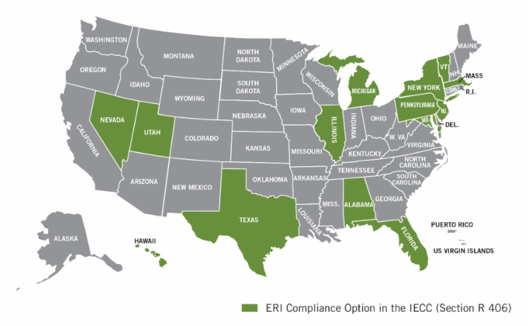No products in the cart.
PA Energy Rating Index Option Now Available to Builders
The Pennsylvania residential energy code has been updated from the 2009 version to the 2015 version. The new state code represents at least a 28% efficiency improvement. This change brings Pennsylvania up to modern homebuilding standards, which now include blower door and duct leakage testing. Another change is the PA Energy Rating Index option.
Introduces PA Energy Rating Index for Code Compliance
Specifically, the state has opted to allow builders to meet the new code by using the PA Energy Rating Index (ERI). This option sets minimum thresholds for a home’s presumed energy consumption and is often met by the evaluation of a RESNET HERS Rater.
In other words, builders choosing the ERI option hire a certified RESNET HERS Rater to perform energy audit testing on a new home. The HERS Rater will ultimately give the home an energy efficiency score. The ERI option identifies which score is acceptable for meeting the building code. In addition, the ERI option requires that minimum envelope requirements and other mandatory measures are met.
The state of Pennsylvania modified the Energy Rating Index scores to reflect the 2018 version of the IECC. Pennsylvania score thresholds are as follows:

In 2017, there were 4,608 homes HERS rated in Pennsylvania. The average HERS Index Scores of homes rated in the state in 2017 was 60. This means that the state’s builders who have their homes HERS rated are meeting the Energy Rating Index option in the new state code.
Pennsylvania builders must meet the provisions of the new energy code on October 1, 2018.
Case Study: Philadelphia to Override State Code Requirement
Unfortunately to some, code rulings are not wholly determined at the federal or state level. Cities and municipalities can override their state’s decision and choose a more strict of the state code (they can’t go backward toward leniency). This recently happened in Pennsylvania.
While the state will adopt the 2015 IECC code, its largest city, Philadelphia, has opted to adopt the newer 2018 IECC standard. Philadelphia is one of the first jurisdictions to move to the latest code.
The new code includes several provisions that impact lighting, such as a requirement for windows and skylights to have automatic daylight-responsive controls and an automatic lighting shut-off provision that requires the use of occupancy sensors in 12 building space types.
This is just one instance of a city overriding its state decision, but it happens everywhere. Therefore, if you’re a builder or contractor looking to be compliant in your area, your best course of action is to contact your local building department, code official, or Authority Having Jurisdiction about exactly what the code requires in your location.
Overview of ERI Code Compliance Nationwide
There are now a total of fourteen states that have adopted the Energy Rating Index option as a compliance option to their state energy code. The states that have incorporated the Energy Rating Index into their energy code are:

- Alabama
- Florida
- Hawaii
- Illinois
- Maryland
- Massachusetts
- Michigan
- Nevada
- New Jersey
- New York
- Pennsylvania
- Texas
- Utah
- Vermont
Get Involved!
If you are a home performance contractor or home inspector looking to gain new business as a result of the Pennsylvania energy code change, consider becoming a certified RESNET HERS Rater. At Everblue, we train professionals just like you on home energy auditing standards, blower door and duct leakage testing, and HERS Rater Certification skills.
For more information about how RESNET HERS Raters play into energy code compliance, check out this 2-minute video:
If you’d like to learn more about earning the RESNT HERS Rater Certification, give us a call at (800) 460-2575 or visit our RESNET HERS Rater training page.